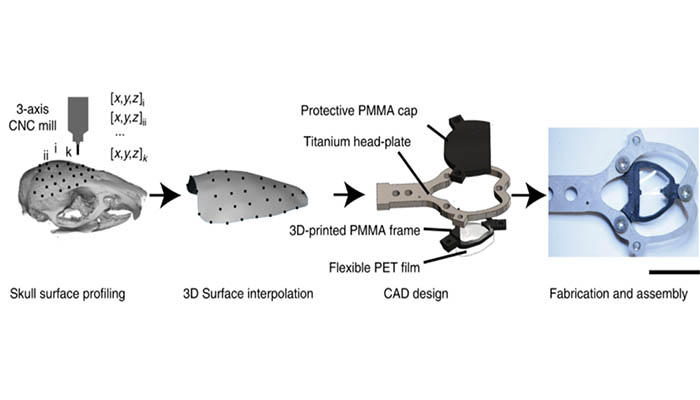See-Shell: 3D printed transparent skull to ‘see’ how the brain works

At the University of Minnesota, researchers have developed a unique 3D printed transparent skull implant for mice. The skull named the See-Shell can be used to view real-time activity on the brain surface and could provide new insights for human brain conditions such as Alzheimer’s and Parkinson’s disease.
Suhasa Kodandaramaiah, Ph.D. and co-author of the study explains, “What we are trying to do is to see if we can visualise and interact with large parts of the mouse brain surface, called the cortex, over long periods of time. This will give us information about how the human brain works.” The study published in the journal Nature Communications states that non-human primates share similar genetics, anatomy, physiology and behaviour to humans; in this case mice provide a good substitute. Timothy J.Ebner, Professor at the University of Minnesota and co-author of the study comments, “These are studies we couldn’t do in humans, but they are extremely important in our understanding of how the brain works so we can improve treatments for people who experience brain injuries or diseases.”

Image via Nature communications
3D Printing the See-Shell
In order to make the See-Shell, the researchers digitally scanned the surface of the mouse’s skull and then used this to model the frame using CAD software. The frame has the same contours as the original skull and was 3D printed out of PMMA (also known as acrylic). On the frame, a thin and transparent PET film was attached forming the window to the mouse’s brain. Following this, the top of the mouse skull was replaced with the 3D printed transparent skull device. Suhasa Kodandaramaiah explains, “This new device allows us to look at the brain activity at the smallest level zooming in on specific neurons while getting a big picture view of a large part of the brain surface over time. Developing the device and showing that it works is just the beginning of what we will be able to do to advance brain research.”

Image via Nature communications
The paper suggests that this transparent device could be adopted for other research projects, it writes: “See-Shells can be fabricated using desktop tools and are inexpensive (<$20 each). Once the individual components are fabricated (or procured from commercial fabrication services), the implant can be assembled in less than 15 min. Therefore, this is a tool that can be readily adopted by most laboratories.”
The following video released by the University shows a sped-up version of the mouse brain scans as seen through the transparent layer of the See-Shell. The researcher explains, “Changes in brightness of the mouse’s brain correspond to waxing and waning of neural activity. Subtle flashes are periods when the whole brain suddenly becomes active.”
You can find the full paper HERE.
What do you thinks of this device? Let us know in a comment on our Facebook and Twitter pages! Don’t forget to sign up for our free weekly Newsletter, with all the latest news in 3D printing delivered straight to your inbox!







